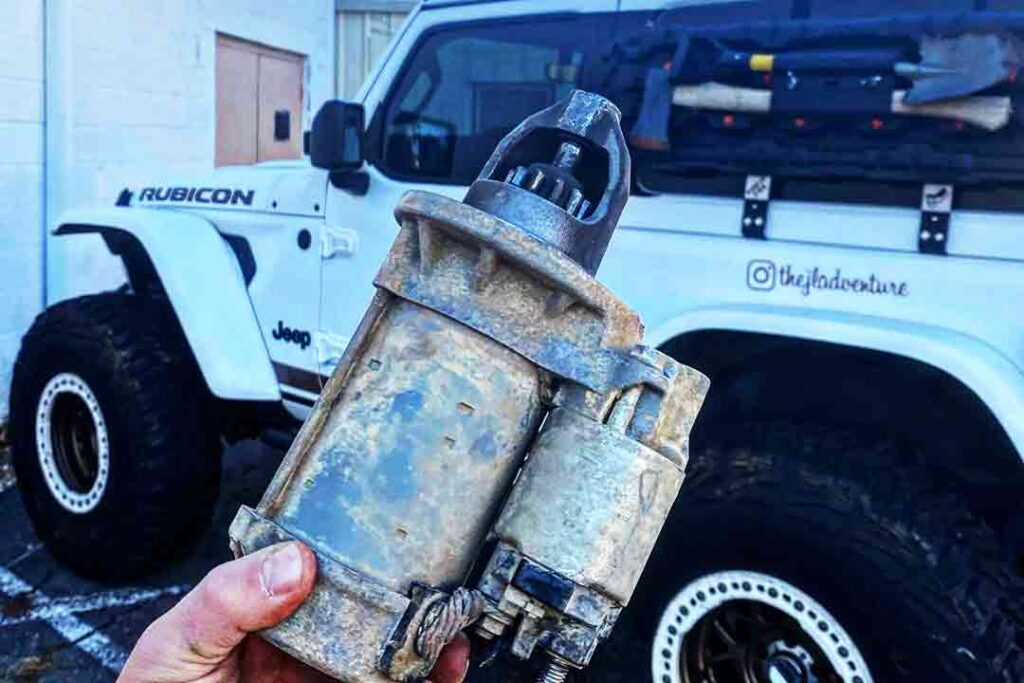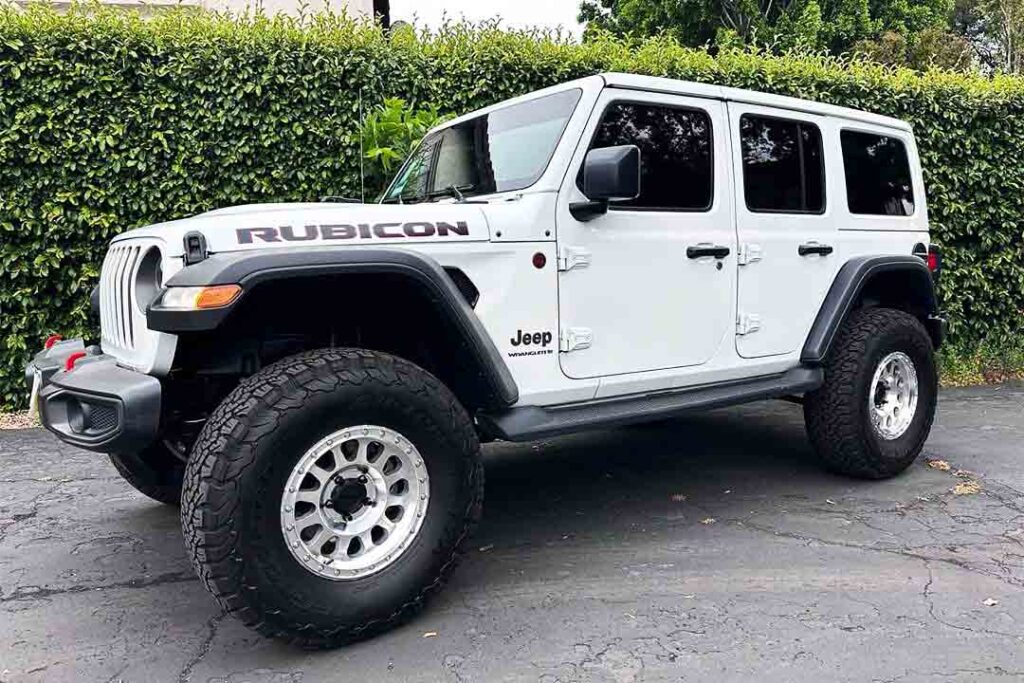Jeep Won’t Start When Hot: What To Do? [Solved]
Jeep owners sometimes experience that their Jeep won’t start when it is hot outside. When your Jeep’s engine repeatedly refuses to start due to heat, and you’re already on the road, it’s a real hassle. Starter failure, dead batteries, bad fuel pump, fuel injector problem, faulty spark plug, etc. are all probable causes of your Jeep’s refusal to start when it’s hot. Having a malfunctioning Jeep starter is the most frequent cause of this problem. As its temperature rises, the starter loses its ability to function properly. The Jeep can’t be started because of this. In this instance, replacing the defective starter with a new one will solve the issue.
In this article, I’ll assist you in figuring out what’s causing the problem and the best course of action. So, let’s jump into the details!
Table of Contents
Most Common Reasons Why Jeep Won’t Start When Hot:
As you may have noticed, I’ve already remarked on the most likely causes of the Jeep’s refusal to start when it’s hot outside. Let’s dig into the technical aspects of the possible reasons below:
1. Starter Problem:
If your Jeep starts immediately when it’s cool but doesn’t do so in hot weather, that’s usually a sign of a problem with the starter. The symptom of a faulty starter is that it makes only a clicking sound but no cranking sound.

The starter is located just beside the motor. When you drive a long way, the engine becomes very hot, and the starter also becomes hot. In hot weather, it takes a long time to be cooled. In this situation, a faulty starter won’t allow the electrical current to flow to start the engine. As a result, your Jeep won’t start; it will just make clicking sounds.
Solution: Replace the old starter with a new one to resolve the problem. You can go to a Jeep mechanic if you prefer a quick and hassle-free replacement. A Jeep engine starter can be purchased for $300-$450; a mechanic’s service charge averages $100-$150.
However, you can avoid paying this service fee if you replace it yourself. Interestingly, it’s easy and less time-consuming.
DIY Jeep Starter Replacement Guide:
Do you want to know whether you can do it by yourself? Replacing a Jeep starter is a relatively easy task. You can do it quickly, even though you are not a professional in this field.
- Step 1: You have to set the parking brake and choke the wheels to prevent the Jeep from rolling. Then disconnect the battery connection to avoid the risk of electric shock.
- Step 2: The starter is located on the driver’s side of the Jeep engine, and a small heat shield may cover it. To remove the starter, first, take the bolt out using a wrench and pull out the positive and ground connections. Then slide it out at that point to remove it.
- Step 3: Now, let’s set up the new one. Place the starter at the mounting point. Pull in the top and bottom bolts with your hand. Once everything is aligned correctly, connect the positive wire to the solenoid at the top of the starter and the ground wire to the bottom bolt. Tighten the bolts using a socket wrench. But be careful; don’t over-tighten.
- Step 4: Reconnect the battery and test out the new starter of your Jeep. Make a test drive and check whether your Jeep is performing perfectly.
This video does a great job of explaining the technical details involved in swapping out a Jeep’s starter. If you replace the starter on your own, you should watch this guide beforehand.
2. Battery Issues:
As you know, the temperature affects the battery charging speed. It decreases at high temperatures. And sometimes, the battery voltage shows alright, but the condition is actually weak. After a break, when you try to restart your Jeep, the weak battery may not have enough charge to start the Jeep right away.
Indicators of a dying or weak battery include certain malfunctions:
- The starter will crank more slowly than usual if this occurs.
- The battery’s condition can also be seen in the intensity of the Jeep’s headlights. It’s a sign of a weak battery if the brightness is lower than usual.
- However, to make sure, you can check the battery voltage using a multimeter. The average voltage of a healthy battery should be more than or equal to 12.6 volts.
Solution: Repairing a wet-cell battery can make it usable again for a certain period, but if you have a dry-cell battery in your jeep, you’ll need to get a new one. The average price of a Jeep battery is around 45$ to 300$ depending on its size, power, and quality. However, you can replace your Jeep battery by yourself very easily. I recommend watching this video guideline below before starting.

Possible Reasons and Solutions for Why Your Jeep Cranks but Won’t Start:
Sometimes it happens that the Jeep cranks but won’t start. Is this your issue?
When attempting to start your Jeep, the cranking sounds indicate that the starter is working correctly. In this context, the most likely causes include a damaged spark plug, a faulty crankshaft position sensor, a poor fuel pump, low compression, and a fuel injector malfunction. Let’s understand these issues in detail below:
1. Faulty Spark Plug
The fuel and air mixture in the engine cylinders needs to be ignited for combustion. The spark plug carries out that function.
Oil leaking, dust, and water reduce the efficiency of the spark plug. Sometimes carbon builds up on the spark plug, which also damages it. As a result, the plug can’t function properly; hence, the Jeep cranks but won’t start. You have to replace your spark plug to solve this issue.
Besides this, the ignition coil malfunctions sometimes. In that circumstance, the spark plug does not receive enough voltage to generate a spark. And as a result, the Jeep engine cranks but fails to start.
2. Faulty Crankshaft Position Sensor
A timely spark is necessary because if it occurs too early or too late, the air and fuel may not burn sufficiently to generate power. The engine control unit won’t be able to ignite the sparks at the right moment if the sensor is damaged, which could prevent the engine from starting. Installing and calibrating a new crankshaft position sensor is necessary to solve this issue.
3. Bad Fuel Pump
Starting your Jeep can be challenging if the fuel pump malfunctions. You’ll hear the engine cranking if that happens, but it won’t turn over. Inadequate fuel delivery from the fuel tank prevents the engine from starting when the fuel pump fails.
Overheating of the engine is a common sign of a malfunctioning fuel pump. An inadequate fuel supply from a damaged fuel pump might cause the engine to overheat and shut down while driving. I advise going to a competent mechanic for an inspection and, if necessary, repairing or replacing the malfunctioning fuel pump.
4. Low Compression Problem
Starting an engine requires air, fuel, compression, and spark. An engine with low compression is tough to start. Low compression can have a variety of causes, such as leaking valves, holes in the piston, blown head gaskets, glazed or splintered cylinder walls, etc. To solve this problem, I’d recommend consulting an experienced mechanic to inspect the exact problem and make the required repairs.
5. Fuel Injector Problem
Due to rust, corrosion, or debris buildup over time, fuel injector nozzles might become dysfunctional. When the fuel injectors become clogged, they can not supply enough fuel to the cylinders to start the engine.
Additionally, overheating the engine increases the risk of clogged injectors. Overheated fuel with increased solid debris can clog the fuel injectors and other fuel system components. I always recommend using only high-quality fuel to keep fuel injectors clean and functioning in the long run.
Read More:
- Jeep Remote Start Not Working: 5 Tips to Solve the Problem
- Key Fob Has Left the Vehicle: 5 Tips to Fix the Error
Wrap Up
According to my research and experience, I’ve tried to explain why the Jeep won’t start when hot, along with possible solutions. If you have read my instructions above, hopefully, you will get a clear idea about the diagnosis and troubleshooting of this problem. Further, if you face any issues regarding this, don’t hesitate to let me know in the comment box! Thank you!
Keep vrooooming!
